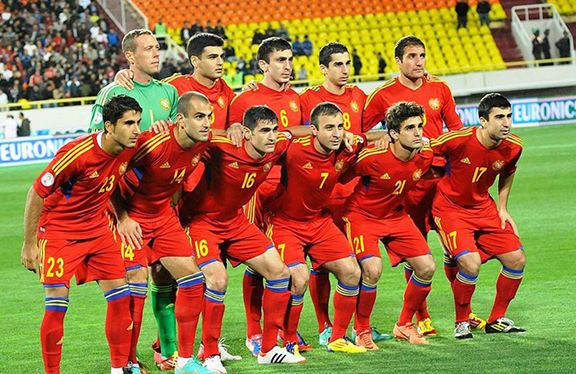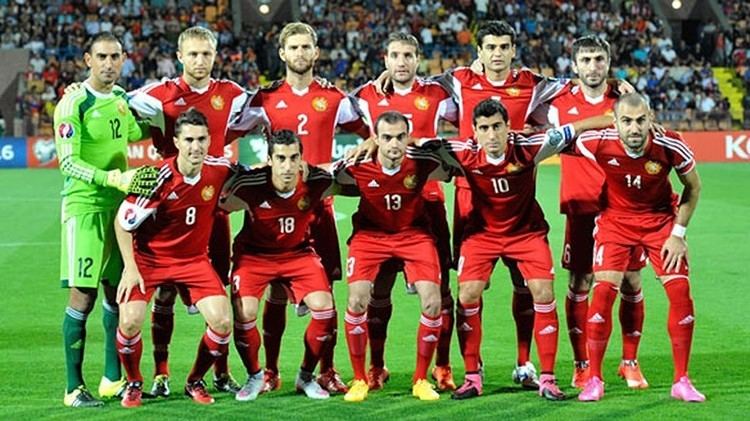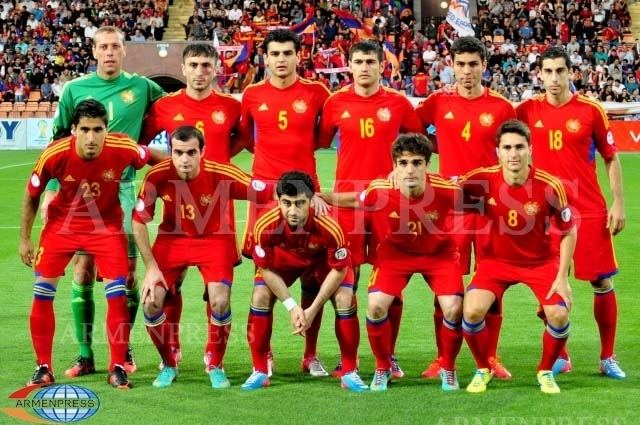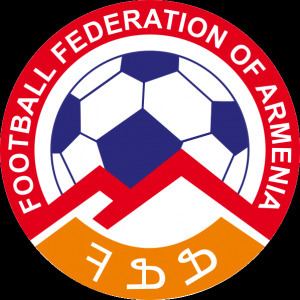FIFA code ARM | Founded 1992 | |
 | ||
Nickname(s) Հավաքական Havakakan (Collective team) Association Football Federation of Armenia | ||
armenia national football team
The Armenia national football team (Armenian: Հայաստանի ֆուտբոլի ազգային հավաքական, Hayastani futboli azgayin havak'akan) represents Armenia in association football and is controlled by the Football Federation of Armenia, the governing body for football in Armenia. After gaining independence from the Soviet Union, the team played its first international match on October 12, 1992. Armenia's home ground is the Republican Stadium in Yerevan and their head coach is Artur Petrosyan. The national team has participated in the qualification of every major tournament from the UEFA Euro 1996 onwards, though they are yet to qualify for the knockout stage in either a UEFA European Football Championship or a FIFA World Cup. In what was the Armenian national squad's greatest success at present, the team came in third place in the UEFA Euro 2012 qualifying stage, with controversial officiating preventing them from achieving second place, and hence moving on to the final tournament.
Contents
- armenia national football team
- History
- Stadium
- Current squad
- Recent call ups
- Records
- 2018 FIFA World Cup qualifying
- Managers
- Nickname
- Jerseys and Colour
- References

History

Armenia became an independent state in 1991, the Armenian SSR having previously played for the Soviet Union national football team. The Football Federation of Armenia was founded on 18 January 1992 and established relations with FIFA in 1992 and with UEFA in 1993. The history of the Armenia national team began on 14 October 1992, when Armenia played its first match against Moldova. That meeting ended in a goalless draw. Since 1996, the team is a member of qualifiers European and World Championships. Armenia has competed in every UEFA Euro qualification and FIFA World Cup qualification since 1994.
The first head coach of the Armenian national squad was Soviet Armenian football star Eduard Markarov. Armenian winner of the UEFA Jubilee Awards and fellow Soviet Armenian football great Khoren Hovhannisyan also became a head coach. Many of the early coaches of the national team never stayed for longer than two years. Scottish coach Ian Porterfield became head coach in 2006 and began to lead the team to some of its first successes in the international stage. Under his leadership, the Armenian team had played a series of great matches with victories over Kazakhstan 2–1, Poland 1–0 and Portugal 1–1, with Cristiano Ronaldo in the lineup. But then tragedy struck; the 62-year-old Porterfield died of cancer, leaving his started work unfinished. An acting assistant coach, Vardan Minasyan, became acting head coach following Porterfield's death. Minasyan learned much from Porterfield and Samvel Darbinyan, another former head coach of Armenia, during this time about coaching and managing. On February 10, 2009, after the draw for the qualifying round teams of the UEFA Euro 2012, by order of the President of the Football Federation of Armenia Ruben Hayrapetyan, Minasyan will continue to lead the Armenian national squad, only now as the official head coach.

In the UEFA Euro 2012 qualifying matches, Minasyan led Armenia in Group B against Russia, Slovakia, Ireland, Macedonia and Andorra. Armenia, considered a heavy underdog, defeated the group favorite Slovakia with two crushing defeats 4–0 and 3–1, defeated Andorra in two matches as well 4–0 and 3–0, drew with Macedonia 2–2 and defeated them in the deciding match 4–1 and tied with the group winners Russia 0–0. The Armenian team scored the most goals out of Group B, with a total of 22. Henrikh Mkhitaryan of Armenia scored 6 goals, the most goals scored by a single player in Group B. The national team almost made the final draw, but controversially lost in a decisive match against Ireland 1–2. Armenian goalkeeper Roman Berezovsky was given a red card by Spanish referee Eduardo Gonzalez at the 26th-minute for supposedly touching the ball outside the goal area. However, replays clearly showed the ball touched his chest and never touched his hands. Replays also showed that Ireland striker Simon Cox had actually touched the ball with his right hand. Despite this, Gonzalez did not penalize Cox. Cox would later admit he touched the ball with his hand. Had Cox’s offence been punished, Armenia would have been awarded a free-kick. Berezovsky was substituted with 19-year-old debuting Arsen Petrosyan. Valeri Aleksanyan later accidentally scored an own goal on Petrosyan, which ended up deciding the match. Armenia and Ireland would each score another goal. The Football Federation of Armenia unsuccessfully filed protest over the match. Gonzalez had later resigned after the match. Despite not getting to play in the UEFA Euro 2012, Minasyan brought the Armenian national team to a record #41 FIFA ranking, placed the team in a personal best third place in the group stage and went on to become the longest leading head coach of the Armenian football team. Minasyan stated he is proud of the entire team. They were all welcomed in the airport back in Armenia as heroes.
Stadium
Hrazdan Stadium was built from 1969 to 1970 on Athens St., Kentron in a period of 18 months with the financial support of the oil magnate Calouste Gulbenkian Foundation. A total amount of 5 million rubles was allocated for Hrazdan. The stadium was named after the slope of the Hrazdan River. It is the largest stadium in Armenia, with more than 70,000 seats. The opening of the stadium took place on 29 November 1970. The Armenia national team played home matches in Hrazdan until 2000. Several Armenian football clubs also played in Hrazdan. In Soviet times, it was one of the largest stadiums in the Soviet Union (among the top four) and one of the few double-tiered stadiums. Hrazdan was the football ground stadium for Ararat Yerevan. Hrazdan Stadium hosted its first official football match on May 19, 1971 when Ararat Yerevan defeated Kairat Almaty 3–0 in front of a record 78,000 spectators. The stadium would host Ararat Yerevan for the final victory of the club in the 1973 Soviet Top League and in the 1973 and 1975 Soviet Cup. The Soviet Union national football team played only two matches at the stadium, both of which date back to 1978. In April of that year, in a friendly game against Finland, the USSR won 10–2. Six months later, in a qualifying match for the UEFA Euro 1980 against Greece the Soviet team won again 2–0. The match with Finland hosted 12,000 spectators and the match with Greece hosted 40,000. The capacity of the stadium decreased from 70,000 to an all-seater of 53,849 spectators. By the second half of 2012, Hrazdan was completely renovated to become the regular venue of the national team's home matches.
The Republican Stadium was renovated in 1999 and, since 2000, has been the home ground for Armenia. The stadium was built in 1953 and finished within a year's time. Republican Stadium has a capacity of 14,968. During the Soviet period and onward from 1953 to 1999, it was known as Dinamo Stadium. The stadium had its official name changed to "Republican Stadium named after Vazgen Sargsyan" in 1999, after Armenian war hero and former Prime Minister of Armenia Vazgen Sargsyan, who died that year. Local clubs Pyunik Yerevan and Ulisses Yerevan play home games in the Republican Stadium. In 2008, the stadium went under a large-scale development in order to modernize the playing surface and to create a high level VIP section and other facilities which met UEFA standards.
Armenia played a match in Hrazdan in 2008 against Turkey after partial renovation earlier that year. The number of seats decreased from 75,000 to 53,849. It is planned to hold Armenia's home matches after a complete renovation in 2012. On 12 October 2012, Armenia played a 2014 FIFA World Cup qualification match against Italy, but has not used Hrazdan since. Hrazdan is used mostly for Armenian football clubs and a number of other athletic competitions.
Current squad
The following players were called up for the 2018 FIFA World Cup qualification match against Montenegro on 11 November 2016.
Caps and goals correct as of November 11, 2016 after the match against Montenegro.
Recent call-ups
The following players were called up in the last 12 months.
Records
Lists of the 10 players with the most caps and top goalscorers for Armenia, as of 11 November 2016 (players in bold are still available for selection):
2018 FIFA World Cup qualifying
Armenia is competing in Group E in qualification for 2018 FIFA World Cup.
Managers
As of 11 October 2016Nickname
The Armenia team is called the Havakakan (Հավաքական), literally the "Collective team".
Jerseys and Colour
The home gear color were previously the Red-Blue-Orange Armenian tricolour, designed by Stepan Malkhasyants. All three colors were on the first Armenian national team jerseys ever designed. The definition of the colors, as stated in government website, is:
The Red emblematizes the Armenian Highland, the Armenian people's continued struggle for survival, maintenance of the Orthodox Christian faith, Armenia's independence and freedom. The Blue emblematizes the will of the people of Armenia to live beneath peaceful skies. The Orange emblematizes the creative talent and hard-working nature of the people of Armenia.In the Euro 2012 qualification matches, played in 2010 and 2011, Armenia's home colors were red-blue-red, produced by Hummel. Beginning with May 2012 friendly with Greece, Armenia switched to all-red home colours and all-white away kit produced Adidas.
